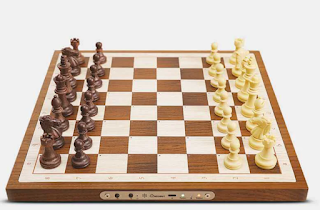Chess, often called the "Game of Kings," has a history that spans centuries. It's a game that combines strategy, intellect, and precision. Over time, technology has played a significant role in shaping the way we play chess. One of the most remarkable innovations in the world of chess is the electronic chess board. In this blog, we'll dive into the fascinating world of electronic chess boards, exploring their history, benefits, and why they've become an integral part of modern chess.
The Birth of Electronic Chess Boards
The concept of
electronic chess board first emerged in the mid-20th century. The idea was to
combine the classic game of chess with the power of computing. The result was a
device that could not only facilitate gameplay but also enhance the overall
experience.
The earliest
electronic chess boards were rudimentary by today's standards. They typically
consisted of a physical board with pieces that had magnetic bases. Underneath
the board, there were sensors to detect the movement of pieces. These movements
were then transmitted to a computer, which would calculate and display the
position on a screen. The computer opponent would respond with its moves,
creating a human-computer chess experience.
Advantages of Electronic Chess Boards
- Accessibility: Electronic chess boards
make chess more accessible to people of all skill levels. Beginners can
benefit from built-in tutorials and hints, while advanced players can
challenge themselves against formidable computer opponents.
- Learning Tool: They serve as excellent
learning tools, offering players the ability to review their games,
analyze moves, and learn from their mistakes. Many electronic chess boards
come with powerful chess engines that provide real-time analysis and
suggest optimal moves.
- Versatility: Electronic chess boards
can be used for various purposes, from solo practice to online multiplayer
games. Some models even allow you to connect to the internet and play
against opponents from around the world.
- Convenience: Unlike traditional chess,
where you need a physical opponent, electronic chess boards enable you to
play anytime, anywhere. You can pause a game and resume it later, making
it perfect for busy individuals.
- Record Keeping: Electronic chess boards
automatically record your games, allowing you to build a database of your
matches. This feature is particularly helpful for players looking to track
their progress and study their strengths and weaknesses.
Modern Features and Innovations
As technology has
advanced, so too have electronic chess boards. Modern models come equipped with
a wide range of features, including:
- Touchscreen interfaces for easy move
input.
- LCD screens that display the board,
eliminating the need for a physical board.
- Adjustable difficulty levels to cater to
players of all skill levels.
- Compatibility with chess software and
databases.
- Voice-guided tutorials and interactive
lessons.
Furthermore,
electronic chess boards have become more affordable and compact, making them a
practical choice for chess enthusiasts of all ages.
Conclusion
The electronic
chess board is a testament to how technology can enhance and modernize
traditional games. Its evolution from the early magnetic sensor boards to
today's touchscreen marvels has made chess more accessible, convenient, and
educational than ever before. Whether you're a beginner looking to learn the
game or a seasoned player seeking a challenging opponent, the electronic chess
board has something to offer. So, next time you sit down to play chess,
consider embracing the electronic revolution and experience the wonders of this
technological marvel for yourself.




.jpg)




0 Comments